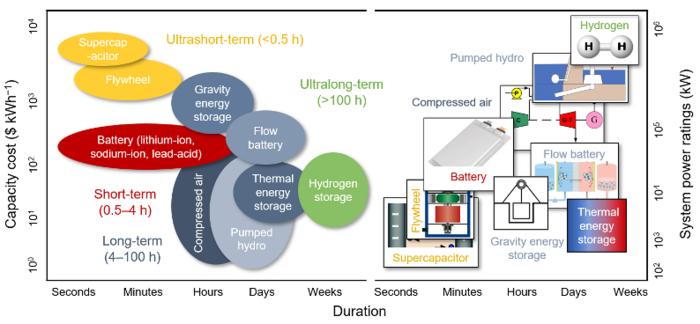As the world grapples with the escalating impacts of climate change, the spotlight increasingly shines on the crucial role of energy storage technologies in achieving carbon neutrality. In an ambitious pursuit towards sustainable development, China is evaluating the dynamics of its power systems, hinging on the strategic integration of electrical energy storage solutions. The pressing need for efficient energy storage becomes evident as the nation faces the intermittent nature of renewable energy sources, which, despite their environmental benefits, are often unreliable in providing a consistent power supply.
Fundamentally, the research illuminates how essential electrical energy storage is in balancing the discrepancies between energy supply and demand. As renewable energy sources become a larger part of the energy mix, the ability to store energy during periods of surplus for use during times of scarcity becomes imperative. The researchers categorize storage solutions based on their duration capabilities, from ultrashort-term technologies like flywheels and supercapacitors to ultralong-term solutions such as hydrogen storage. In doing so, they delineate a clearer picture of how these technologies can be utilized effectively across the energy spectrum.
Projected economic analyses further solidify the relevance of these storage technologies. The levelized cost of storage (LCOS) for lithium-ion batteries is anticipated to decrease by 33% by 2030. This impressive decline positions lithium-ion systems as increasingly cost-effective solutions for sub-four-hour applications. On the horizon, it’s also important to note that hydrogen storage is expected to achieve cost parity in ultralong-duration applications by 2035. These projections suggest a shifting paradigm wherein energy storage becomes not merely a necessity but an economically advantageous choice for renewable integration.
Geographical considerations also play an integral role in the deployment strategies for these technologies. A regional approach is critical, with the Northwest of China favoring hybrid systems that combine lithium-ion and hydrogen storage to maximize the utility of their abundant solar and wind resources. Conversely, the Northeast adopts a strategy that incorporates thermal-energy hybrid storage, designed specifically to counteract the adverse effects of harsh winters on electrochemical systems. By tailoring strategies to regional capabilities and resources, China can enhance its energy resilience and security.
Policies designed to accelerate the adoption of electrical energy storage are essential. The study recommends multifaceted initiatives to stimulate further development, including research and development incentives targeting solid-state batteries and high-efficiency electrolyzers. Market mechanisms must be established to provide compensation for grid services, ensuring that storage technologies can be readily integrated into existing systems. Furthermore, financial tools tailored to regional needs, such as tax rebates and infrastructure REITs, could foster an environment conducive to innovation and investment.
Beyond technological advancements, nurturing a workforce skilled in this burgeoning field is of paramount importance. The research emphasizes the need for academic programs and vocational certifications that equip individuals with the necessary skills to meet the demands of a rapidly evolving industry. As the reliance on electrical energy storage technologies escalates, fostering talent within the workforce ensures that the sector can expand efficiently while also addressing current skill gaps.
Professor Qiang Zhang, the lead author of the study, encapsulates the significance of their research succinctly: “Energy storage is the linchpin of China’s decarbonization strategy.” The foundational techno-economic insights provided by this study serve as a policy blueprint that aligns storage deployment with regional needs, ensuring that the transition toward carbon neutrality is not only reliable but also economically sustainable.
As the research cites, achieving the ambitious 2060 carbon neutrality target will require scalable, diversified storage solutions capable of balancing resilience, security, and sustainability across the grid. The urgency of systematic advancement in energy storage technologies cannot be overstated, given China’s provincial energy profiles and the pressing global trends in levelized cost of storage. Engaging a more diversified array of storage solutions will enhance both energy security and environmental sustainability.
In tandem with support from prominent programs such as the National Natural Science Foundation of China and corresponding research initiatives, this vital work is set to impact the landscape of energy storage technology significantly. The study stands as a clarion call for accelerated action and innovation in the sphere of electrical energy storage as a core component of China’s energy transition roadmap.
Indeed, the proactive approach to integrating electrical energy storage not only propels China towards its climate goals but also sets a precedent for global efforts in combating climate change. As the research underscores, scholarly inquiry, innovative policy, and robust workforce development represent critical strands in the complex tapestry of sustainable energy futures.
Subject of Research: Electrical energy storage technologies for carbon neutrality in China
Article Title: The shifting technology landscape of electrical energy storage toward carbon neutrality in China
News Publication Date: 23-Jan-2025
Web References: http://dx.doi.org/10.26599/TRCN.2025.9550004
References: Technology Review for Carbon Neutrality
Image Credits: Technology Review for Carbon Neutrality, Tsinghua University Press
Keywords
Energy storage, carbon neutrality, lithium-ion batteries, hydrogen storage, renewable energy, economic analysis, technological advancements, decarbonization, grid stability, Tsinghua University.
Tags: carbon-neutral power systems Chinaclimate change impact mitigationeconomic viability of energy storageelectrical energy storage solutionsenergy supply and demand balanceProfessor Qiang Zhang researchrenewable energy storage technologiesresearch on energy storage technologiesroadmap for carbon neutralitysustainable energy developmentTechnology Review for Carbon NeutralityTsinghua University energy storage strategy





